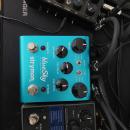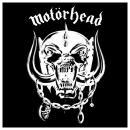Bueno, hay que decir que el puente de la stratocaster está preparado para ir hacia adelante y hacia atrás.
En la página web de Fender, indican muy claramente que el ajuste del puente es dejándolo levantado 1/8 de pulgada por la parte de atrás (3,2 mm), por lo que tienes ese margen para subir de tono. También indican que se puede colocar pegado al cuerpo pero siempre manteniendo la presión justa de los muelles, nunca sobreapretarlos.
http://www.fender.com/support/stratocaster_setup_guide.php
---
TREMOLO
Stratocaster guitars can have four distinctive types of bridges. The most well-known bridge is the vintage-style "synchronized" tremolo. The other three are the American Series bridge, which is a modern-day two-pivot bridge; the non-tremolo hardtail bridge; and a locking tremolo, such as the American Deluxe or Floyd Rose® locking tremolos. If you have a non-tremolo "hardtail" bridge, proceed to "Intonation (Roughing it out)." If you have a locking tremolo bridge, click here.
First, remove the tremolo back cover. Check your tuning. For a vintage-style tremolo bridge, a great way to enhance its performance is to pull the bridge back flush with the body using the tremolo arm. Then loosen all six screws located at the front edge of the bridge plate, raising them so that they all measure approximately 1/16" (1.6 mm) above the top of the bridge plate. Then tighten the two outside screws back down until they're flush with the top of the bridge plate. The bridge will now pivot on the outside screws, leaving the four inside screws in place for bridge stability. For a two-pivot model such as the American Series bridge, use your tremolo arm to pull the bridge back flush with the body and adjust the two pivot screws to the point where the tremolo plate sits entirely flush at the body (not lifted at the front or back of the plate).
Allowing the bridge to float freely (no tension on the tremolo arm) using the claw screws in the tremolo cavity, adjust the bridge to your desired angle—Fender spec is a 1/8" (3.2 mm) gap at rear of bridge. You'll need to retune periodically to get the right balance between the strings and the springs. If you prefer a bridge flush to the body, adjust spring tension to equal string tension, while the bridge rests on the body (you may want to put an extra 1/2 turn to each claw screw to ensure that the bridge remains flush to the body during string bends). Caution: Do not over-tighten the springs, as this can put unnecessary tension on the arm during tremolo use. Finally, you may wish to apply a small dab of Chapstick® or Vaseline® at the pivot contact points of the bridge for very smooth operation.
---
Salud.





 ahora revisa bien que puente tienes y si es estandar lamento decirte que no podras... ya que esta atornillado al cuerpo de la guitar y no posee ningun espacion atras de este para el moviento hacia arriba ok... espero te sirva:cool:
ahora revisa bien que puente tienes y si es estandar lamento decirte que no podras... ya que esta atornillado al cuerpo de la guitar y no posee ningun espacion atras de este para el moviento hacia arriba ok... espero te sirva:cool: 






